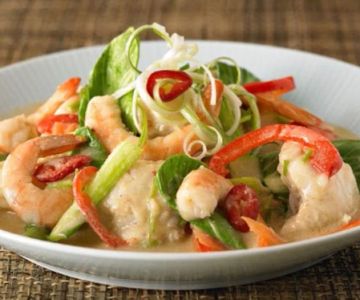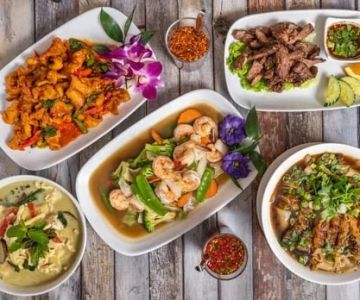
How to Make Thai Food That’s Cozy Enough for Winter Nights
- 1. Why Thai Food Is Perfect for Winter
- 2. Warm Thai Dishes for Cold Nights
- 3. Essential Ingredients for Cozy Thai Recipes
- 4. Tips for Cooking Thai Food in Winter
- 5. Bringing Thai Flavors to Your Home
1. Why Thai Food Is Perfect for Winter
When the temperature drops and nights get longer, nothing beats a bowl of steaming hot, flavorful Thai food. The beauty of Thai cuisine lies in its balance of heat, sweetness, acidity, and richness — all of which create an experience that feels both warming and refreshing. Dishes like Tom Yum and Thai curries deliver just the right level of spice to warm you from the inside out while offering comfort through their aromatic depth.
Unlike heavy winter comfort foods, Thai meals often remain light yet satisfying. Coconut milk-based soups, for example, provide richness without being overly dense, while the use of herbs like lemongrass and galangal helps with digestion — perfect after a long day out in the cold. Thai food proves that winter comfort can also be vibrant and energizing.
2. Warm Thai Dishes for Cold Nights
When it comes to cozy Thai food for winter, some dishes stand out for their warming qualities and bold flavors. Here are a few must-try favorites that make any winter night more enjoyable:
- Tom Kha Gai (Chicken Coconut Soup): This creamy, fragrant soup made with coconut milk, lemongrass, and galangal is the definition of comfort. It’s light yet filling, with a soothing warmth that pairs perfectly with steamed jasmine rice.
- Massaman Curry: Known for its rich, nutty flavor and slow-cooked tenderness, Massaman curry combines coconut milk, potatoes, and meat (often beef or chicken) in a thick, aromatic sauce that feels like a hug in a bowl.
- Pad Kee Mao (Drunken Noodles): These stir-fried noodles deliver bold, spicy flavors and hearty textures that make them perfect for cold evenings. The combination of fresh basil, garlic, and chilies creates an irresistible heat.
- Thai Hot Pot (Jim Jum): A communal favorite, this clay pot soup is cooked right at the table with vegetables, glass noodles, and marinated meat. It’s the perfect dish for family dinners during chilly nights.
3. Essential Ingredients for Cozy Thai Recipes
Creating authentic Thai dishes at home starts with using the right ingredients. Many of these not only enhance the flavor but also contribute to the warming quality of the dishes — ideal for winter cooking. Here are some essentials to keep stocked in your pantry:
- Coconut Milk: The backbone of many Thai soups and curries, coconut milk adds a creamy texture and subtle sweetness that balances heat from chilies.
- Lemongrass and Galangal: These two herbs are key for achieving authentic Thai aromas. Lemongrass brings a citrusy brightness, while galangal adds a peppery warmth.
- Thai Chilies: They’re small but mighty. Adjust the heat to your liking, but a touch of chili can instantly transform a dish into something cozy and invigorating.
- Fish Sauce: Essential for umami depth, fish sauce gives Thai dishes their characteristic savory complexity, tying all the flavors together.
- Fresh Herbs: Basil, cilantro, and kaffir lime leaves not only elevate the aroma but also help balance the intensity of spicier dishes.
Many of these ingredients can be found at Asian supermarkets or specialty stores. For high-quality Thai cooking essentials and tools, visit Thai Food, where you’ll find curated ingredients perfect for both novice and experienced home chefs.
4. Tips for Cooking Thai Food in Winter
Cooking Thai food during the winter requires a few simple adjustments to make your dishes even cozier and more satisfying. Here are some helpful tips:
- Go heavier on coconut milk: A little extra coconut milk can make soups and curries creamier and richer, providing extra warmth for cold nights.
- Use seasonal vegetables: Incorporate winter veggies like squash, carrots, or sweet potatoes into Thai curries for a seasonal twist that enhances the dish’s texture and flavor.
- Adjust spice levels: During colder months, many people crave a little more heat. Add extra chili or ginger to boost warmth without overpowering the other flavors.
- Make large batches: Thai dishes like curries and soups often taste even better the next day as the flavors meld. Prepare a big pot and enjoy it throughout the week.
Winter is also the perfect time to experiment with new recipes and cooking techniques. Whether you’re slow-simmering a Massaman curry or creating your own Tom Yum broth, the aromas alone will fill your kitchen with a comforting, inviting warmth.
5. Bringing Thai Flavors to Your Home
One of the best things about Thai cuisine is how easy it is to adapt it to your own taste while keeping its signature warmth intact. Cozy Thai food is more than just about spice — it’s about balance. The mix of sweet, sour, salty, and spicy elements creates harmony that feels comforting yet exciting.
On a cold winter evening, few things are more satisfying than curling up with a bowl of Thai curry or a hot noodle soup that you made yourself. For inspiration, high-quality ingredients, and Thai cookware, check out Thai Food. Their range of products makes it easy to bring authentic Thai flavors into your home this winter and beyond.







 Lemongrass Restaurant & Sake Bar4.0 (323 reviews)
Lemongrass Restaurant & Sake Bar4.0 (323 reviews) Dagg Thai Restaurant4.0 (1853 reviews)
Dagg Thai Restaurant4.0 (1853 reviews) Siam Deluxe4.0 (135 reviews)
Siam Deluxe4.0 (135 reviews) Chalong Southern Thai4.0 (3281 reviews)
Chalong Southern Thai4.0 (3281 reviews) Little Thai Kitchen4.0 (421 reviews)
Little Thai Kitchen4.0 (421 reviews) Udom Thai4.0 (636 reviews)
Udom Thai4.0 (636 reviews) Thai Food Ingredient Spotlight: Kaffir Lime Leaves & Their Unique Aroma
Thai Food Ingredient Spotlight: Kaffir Lime Leaves & Their Unique Aroma How to Make Thai Food That’s Great for Meal Prepping
How to Make Thai Food That’s Great for Meal Prepping Best Thai Meat Recipes for Meat Lovers Seeking Something New
Best Thai Meat Recipes for Meat Lovers Seeking Something New Thai Food for Apartment Living: Simple, Flavorful & Budget-Friendly
Thai Food for Apartment Living: Simple, Flavorful & Budget-Friendly The Best Thai Food Recipes for Couples Cooking Together
The Best Thai Food Recipes for Couples Cooking Together How to Make Thai Food That’s Balanced for a Healthy Lifestyle
How to Make Thai Food That’s Balanced for a Healthy Lifestyle